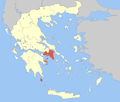Attica (region)
| Attica Περιφέρεια Αττικής | ||
|---|---|---|
| Administrative region of Greece | ||
| ||
 | ||
| Coordinates: GR 38°00′N 23°42′E / 38.0°N 23.7°ECoordinates: GR 38°00′N 23°42′E / 38.0°N 23.7°E | ||
| Country |
| |
| Decentralized Administration | Attica | |
| Capital | Athens | |
| Regional units | ||
| Government | ||
| • Regional governor | Rena Dourou (SYRIZA) | |
| Area | ||
| • Total | 3,808.10 km2 (1,470.32 sq mi) | |
| Population (2011)[1] | ||
| • Total | 3,828,434 | |
| • Density | 1,000/km2 (2,600/sq mi) | |
| Time zone | EET (UTC+2) | |
| • Summer (DST) | EEST (UTC+3) | |
| ISO 3166 code | GR-I | |
| GDP(nominal)[2] | 2014 | |
| - Total | €86/ $115 billion | |
| - Per capita | €22,000/ $30,000 | |
| Website |
www | |
Attica (Greek: Αττική, Attikí; IPA: [atiˈci]) is an administrative region that encompasses the entire metropolitan area of Athens, the capital of Greece. The region is coextensive with the former Attica Prefecture of Central Greece, but covers a greater area than the historical region of Attica.
Overview
Located on the eastern edge of Central Greece, Attica covers about 3,808 square kilometers. In addition to Athens, it contains within its area the cities of Piraeus, Eleusis, Megara, Laurium, and Marathon, as well as a small part of the Peloponnese peninsula and the islands of Salamis, Aegina, Poros, Hydra, Spetses, Kythira, and Antikythera. About 3,750,000 people live in the region, of whom more than 95% are inhabitants of the Athens metropolitan area.
Administration
The Attica region was established in the 1987 administrative reform, and until 2010 comprised the 4 prefectures of Athens, East Attica, Piraeus and West Attica.
With the 2010 Kallikratis plan, the region's powers and authority were completely redefined and extended. Since 1 January 2011, the region represents the second-level local administration. While being supervised by the Decentralized Administration of Attica, it is now an independent self-governing body with powers and a budget comparable to the former prefectures.
The region is subdivided into eight subordinate regional units:[3]
The region's governor is Rena Dourou (SYRIZA), who on 1 September 2014 succeeded Giannis Sgouros following the 2014 local elections.
Electoral districts
The Attica region consists of five electoral districts: Athens A, Athens B, Piraeus A, Piraeus B and Attica.
Major communities
|
|
Transportation
Roads and highways
The main roads and highways of Attica are:
- Motorway 1 (Athens-Thessaloniki)
- Motorway 6 (northern beltway of Athens)
- Motorway 8 (Eleusis-Corinth)
- Motorway 62 (Athens Airport link)
- Motorway 64 (eastern beltway of Athens)
- Motorway 65 (western beltway of Athens)
- Motorway 642
- Greek National Road 1 (old road Athens-Thessaloniki)
- Greek National Road 3 (Eleusis-Lamia-Florina)
- Greek National Road 8 (old road Athens-Patras)
- Greek National Road 79
- Greek National Road 83 (Marathonos Avenue)
- Greek National Road 89
- Greek National Road 91
Ferry lines
Numerous ferry lines, both normal ferries and the "flying dolphins" (fast sea vessels), connect the port of Piraeus with the islands of the region.
Other
- Athens Mass Transit System
- Athens Metro
- Athens Tram
- Proastiakos
- Transit System (Attica)
Sports
Football clubs
|
All sports
Mini football |
References
External links
| Wikimedia Commons has media related to Attica. |
- Official website (Greek)

